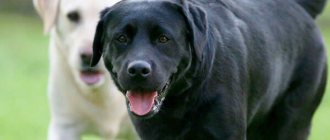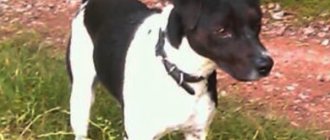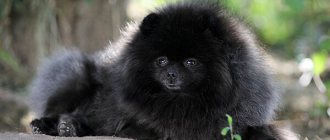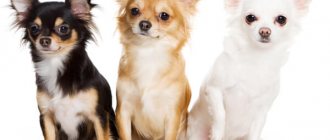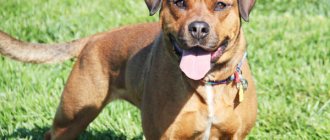Pure black coloring is rare in Chihuahuas.
Dogs with this coat color look very elegant, especially if they have a small white tie-like marking on their neck. But the most common Chihuahuas are black and tan.
But due to the fact that most breeders prefer to breed dogs of other, more fashionable colors, people who decide to get a black Chihuahua may have to spend a lot of time looking for a pet.
History of appearance
The first coal-black dogs were already found among the ancestors of the Chihuahua, called Techichi. These small, rather short-legged and stocky dogs, unable to bark, lived in Mexico back in the 15th century BC.
NOTE!
Techichi were bred by the Toltecs and were considered sacred animals. When in the 12th century AD. Aztec tribes came to these lands and ousted the Toltecs, the Techichi retained their status and began to be considered sacred among them. True, this was not always a good thing for dogs, since they were often sacrificed to the gods or buried with the deceased owner.
After Mesoamerica was conquered by the Spaniards, the Techichi found themselves in serious danger due to the fact that the Spaniards destroyed them during the destruction of Indian temples.
Several of these dogs managed to escape into the forest and hide there for several centuries. During this time, the Techichi, left to their own devices, interbred with each other, and possibly with other feral dogs. And when at the beginning of the 19th century several of these animals were caught and domesticated by local residents, they were no longer Techichi, but a completely different breed.
Among the dogs that were bred and later sold to foreign tourists by Mexicans were black dogs, which became the ancestors of modern black Chihuahuas.
Read more about the history of the Chihuahua here.
Color
There are different colors of Chihuahuas. The most unique is considered to be a silver-gray shade of wool with a blue tint. Due to the fact that this color is very rare, the cost of a “blue” Chihuahua sometimes reaches tens of thousands of dollars.
Based on accepted standards, the following colors and their mixture are acceptable:
- black;
- black and white;
- black and silver;
- black with pronounced tan marks;
- "chocolate";
- “chocolate” with scorch marks;
- chocolate tricolor;
- brindle;
- grey;
- grey-silver;
- ginger;
- fawn-red;
- beige;
- cream;
- cream with white;
- blue (noted above);
- lilac.
Marriage or breed?
Since all colors, except merle, are currently standard for Chihuahuas, a pure black color cannot be regarded as a defect in the breed.
Expert opinion
Kozhevin Semyon Kirillovich
Expert dog handler.
Black color is considered one of the main ones. Black Chihuahuas can be carriers of any other gene and such dogs are convenient for breeding. But you need to remember that a black Chihuahua, which is a carrier of chocolate or red color, may have a brownish tint to its coat, and in some cases even look dark brown. Such a dog, in addition, may have an undercoat of a different color - grayish or light fawn, which is especially noticeable in long-haired dogs.
Change in fur color saturation
Often there is a change in the saturation of the coat of a Chihuahua. As a rule, a similar phenomenon is observed in puppies under 1 year of age.
When hair pigmentation is just being formed, the pigment is distributed throughout the hair. Saturation may decrease or increase. For example, a fawn color can lighten to beige, or, on the contrary, intensify to red (golden). It is difficult to predict such a change, but it is more often observed in puppies with light colors.
Deviations in the shade of fur are also possible in adult individuals in case of serious damage to the nervous system, internal organs, vision or hearing, sometimes for completely unknown reasons. There are rumors that even from food. And in old age, there may be a slight or significant appearance of gray hairs on the dog’s face and body, most noticeable in sunlight.
What color did you like?
Naturally, I presented to your attention only a small part of the existing Chihuahua colors. In fact, there are more than 90 of them, and even a professional can find it difficult to navigate them all. They all represent different color combinations listed above. But it is not at all necessary to know them all, because the choice is limited by the supply on the market and your financial capabilities. Unique and rare colors cost a lot of money. There is no need to chase luxury and exclusivity, because next to you there are many newborn Chihuahua puppies who are looking forward to their owner, affection and care!
Please write in the comments which of the presented color options did you like best? I will also be glad if you share this material on social networks by clicking on the buttons below. Well, I’m always ready to listen to criticism and suggestions on the topic of the article, because... I could also be wrong about something.
Advantages and disadvantages
Pros:
- look elegant and stylish;
- sociable and affectionate;
- distinguished by loyalty and devotion;
- they don’t need a lot of space in the house;
- if necessary, without hesitation they rush to protect the owner;
- sensitive and distrustful of strangers, which makes them good guards;
- willingly use the tray and diaper;
- easy coat care;
- love traveling;
- with the right approach they are easy to train.
Minuses:
- monogamous, tend to choose one owner;
- not suitable for families with children under 11-12 years of age;
- need very careful handling, as they have fragile bones and an open fontanel;
- may be jealous of the owner of other dogs and even children;
- they are cocky and do not get along very well with dogs of other breeds;
- an individual approach to training is needed.
IMPORTANT!
If not raised correctly, a black Chihuahua can grow up to be aggressive and even biting.
Dimensions, weight and other features
The height of a black Chihuahua does not exceed 23 cm, and its weight ranges from 0.5 to 3 kg. Standard size dogs weigh between 1.5 and 3 kg.
This is a small, elegant and proportional dog of approximately square format.
The head is apple-shaped, the stop is clearly visible, the muzzle is not too long.
The ears are erect, triangular, and widely spaced.
The eyes are large, round and expressive, and their most preferred color is dark brownish.
The color of the nose is black.
The neck is elongated, similar to that of a deer. The back is straight, the croup is slightly sloping. The chest reaches the elbows, is wide and quite voluminous.
The forelimbs and hind limbs are straight, and the hind limbs are slightly longer and slightly pulled back.
The tail is of medium length, set rather high, not docked.
The color of a black Chihuahua should be as rich as possible, and its coat should be shiny, well-groomed and clean. Small white markings are allowed.
Rare colors of Chihuahua
Rare Chihuahua colors include chocolate, white, brindle, lilac (lilac) and blue. They, like common colors, can have a huge number of combinations. Let's look at the most famous ones.
Related article: When and how to properly breed a Chihuahua
- Chocolate
Chocolate implies brown fur with a warm reddish tint (the pads on the paws and nose should also be brown). It can be clean or with small marks on the paws and chest. The “sable” type has a chocolate base color, the rest is like a red sable. At the same time, small milky inclusions are unacceptable: white should either be expressed in clear spots (can be on the head, chest, tail and paws), or it should not be there at all. “Sable” can also be chocolate-red: a light chocolate shade with the same dark stripe from head to tail. There is a tan color option with lightened areas. The chocolate tricolor looks interesting: a predominantly white body (in some cases there may be brown specks on it - the so-called specks) with a chocolate-colored cloak and light red tan.
- White
The white color of the Chihuahua is also found in its pure form. In this case there should be no marks or specks. This coat color is complemented by pink skin, black or brown nose and claws.
Often white serves as a “background” for other colors. There may be large red, gold and chocolate spots. Individuals with cream-colored markings look elegant. Spectacular graphics are inherent in individuals of the black and white type.
- brindle
There are a lot of variations here. In Chihuahuas, the brindle color is considered to be either fawn of any gradation or thick black. The brindle coloring allows for many types of patterns, for example, light fawn with black stripes or deep black diluted with fawn and tan. You can also find a dog whose white “base” is painted with tiger spots located on the head and/or body.
- Lilac
A beautiful and rare variety. There may be different saturation options. This Chihuahua's fur can be so light purple in color that it literally looks pink (called an Isabella). A dark purple coat type is also possible. White tips on the paws and small spots on the chest are allowed (tan type). Lilac allows options with large white spots on the main background (can be located anywhere except on the sides and back) or, conversely, purple spots with a main white background. A lilac tricolor is possible. A long-haired individual of this type looks especially impressive.
Similar article: Chihuahua breed weight table by month
- Blue
The blue Chihuahua can be either a rather dark gray color or a very delicate, smoky color. There are variants of blue color with white splashes on the chest and tips of the paws; large, clearly defined white spots on a blue background are acceptable, and vice versa. The blue and white variety is sometimes decorated with specks. This type has a beautiful tricolor: a blue cloak on a white body with light red tan.
Breed varieties + photos
Smooth-haired
The coat is short, smooth, close-lying and shiny, and can be with or without undercoat.
Shorthair
Invalid coat type. Longer than smooth, but noticeably shorter than long-haired dogs.
Longhair
The coat is fine, long, soft, straight or slightly wavy, but not curly or downy. It forms beautiful fringes in the form of black fringe on the ears, as well as in the form of a collar on the neck and pants on the limbs.
Mini
Mini Chihuahuas differ from standard Chihuahuas in weight - it should not be less than 1 kg and not exceed 1.5 kg.
Micro
These black dogs can be considered one of the smallest breed varieties in the world - their weight is 0.5-1 kg.
NOTE!
Mini and micro Chihuahuas differ from standard ones not only in size, but also in slightly worse health and a shorter life expectancy.
Cobby
Black Chihuahuas of this type are characterized by such features as a strong physique, fairly good muscularity, a relatively large head with a strongly convex forehead and a short muzzle. Their eyes are dark, large, expressive and widely spaced. The ears are not too large, erect, triangular in shape, set rather low.
Dir
Chihuahuas of the Dir type look like figurines carved from ebony. They are elegant and very graceful. Their medium-sized heads with large, high-set ears and an elongated muzzle are very reminiscent of deer. The bones of these dogs are lighter than those of the Cobby, and the muscles are less developed.
Kinds
Today, the standard allows for 2 basic types of Chihuahuas, Deer and Cobby. Let's take a closer look at them.
1. Dir. In English this word is translated as “deer”. Indeed, such small dogs are very reminiscent of this proud forest animal. Their ears are set like deer antlers, high and parallel. Limbs are long and slender. The dog of this variety looks very presentable. Moves gracefully, without jerking.
2. Kobby. Compared to the dir, it is more clumsy, massive and heavy in terms of gait. The height of a cobby is approximately 2 cm less. But in strength, such a dog is superior to its closest brother. The main difference between cobby and dir is its large and pronounced head, similar to a large and ripe fruit. This dog has short but stable legs.
But that is not all. Chihuahuas are also divided depending on the length of their fur. They can be short-haired or long-haired. The main thing is that the animal’s fur is smooth to the touch, and when you look at it under the sun, it shines. In the second case, the standard allows for slight waviness.
Important! A representative of this breed cannot be curly.
Life expectancy and health
The lifespan of standard representatives of the breed is on average 12-15 years.
In general, black Chihuahuas are in good health, but are predisposed to certain diseases :
- hypoglycemia;
- hydrocephalus;
- demodicosis;
- dislocated kneecaps;
- cataract;
- respiratory diseases;
- urolithiasis disease;
- diseases of the oral cavity.
Some dogs of this breed are also predisposed to allergies and dermatitis.
Characteristics of the black chihuahua
Black Chihuahuas differ from other representatives of the breed only in their color. Miniature pets are companion dogs. The variety is considered the only one whose ancestors were small in size. Other decorative dogs were obtained as a result of selective selection and experiments with animals of average height.
Chihuahuas are harmoniously built - proportional body, small head, high-set tail. The dogs are active, courageous, mentally stable, and have high intelligence. Sneezes are infinitely loyal to their owner, but do not like to be shouted at. They are touchy, but at the same time have a peaceful attitude and always meet people halfway.
Does a puppy's color change as it ages?
Most black Chihuahua puppies do not fade and retain their jet black coat color. An exception may be dogs that were born black, but later began to change color to sable. But they are noticeable almost immediately, since their coat color is not black, but rather brownish.
IMPORTANT!
Black Chihuahuas that carry the brown, red, or fawn gene may appear dark brown or brownish. In order to determine what color a dog is, just look at its nose - if it is brown, then the dog is chocolate. True black Chihuahuas will always have a black nose.
Benefits of Brown Chihuahuas
One of the most unique colors is chocolate or brown Chihuahua puppies. Chocolate brown Chihuahua puppies are head and shoulders above the rest. They have beautiful dark chocolate hair, and their eyes light up in the light wind. This is a very active, lively little dog and if you love being with the family dog, then this is the puppy for you.
© shutterstock
Brown Chihuahuas need to remember their parents, but they also like to have their names changed to something else. Naming your Chihuahua "Chloe" will make her adorable and different from other little Chihuahuas. Other popular name options for Chihuahua puppies include "Parker", "Frosty", "Izzy", "Barry" and "Rory". Naming your little dog after a family member is a great way to stay connected and maintain strong family bonds.
Rules of care
For a smooth-haired black Chihuahua, brushing 2 or 3 times a week is sufficient. For long-haired individuals, daily combing with a comb is recommended.
There is no need to bathe Chihuahuas often, as these dogs get cold easily.
Your pet's eyes, ears, and teeth should be examined daily and cleaned as needed. To slow down the formation of plaque in your dog, you can let him chew on a toy or treat purchased at a pet store.
Nails are trimmed as needed using a nail clipper.
NOTE!
In the summer, before going for a walk, these dogs must be dressed in a light, light suit and a white or light-colored headdress placed on the pet’s head.
You can't do without clothes even in rain or cold weather. A black Chihuahua must have at least two overalls. One is made of waterproof fabric, for autumn, and the other is insulated, for winter.
Care and maintenance of the black chihuahua
There are no particular difficulties in caring for a dark Chihuahua. They need regular examination of eyes, ears, teeth, standard hygiene procedures and proper, balanced nutrition. Dogs need to be walked, taken care of their health and vaccinated.
Care for the coat, eyes and ears
A Chihuahua with short black fur is brushed three times a week. For long-haired species, the procedure should be daily using a comb. Regular grooming helps to increase blood circulation in the skin and saturate the hair follicles with nutrients.
Wet tear stains may form around the eyes of a sneezer. To prevent infection, they are treated daily with cotton pads soaked in boiled water or eye lotion. If purulent discharge and redness of the eyes appear, seek help from a veterinarian.
Once a month, dogs' ears are cleaned of dirt and excessive accumulation of wax. The procedure requires cotton pads, swabs and zoo lotion.
Feeding
The black Chihuahua can be fed both natural food and ready-made industrially produced pellets. For decorative dogs, choose high-quality premium, super-premium or holistic food. It is not advisable to buy “drying”, which contains wheat, corn, dyes and preservatives.
Dishes made from natural products should contain lean meat (poultry, beef, lamb), sea fish, cereals, cottage cheese, kefir, boiled eggs, vegetables and fruits. The content of protein products is at least 2/3 of the entire diet. It is unacceptable to feed Chihuahuas sweets, milk, baked goods, legumes, fried and fatty foods, and raw meat.
Training and education
Dark Chihuahuas are smart and quick-witted, they are able to learn commands quite quickly, but the process needs to begin at 2-3 months. Perseverance is required when learning. The result should be:
- Socialization - Chihuahuas cease to be dangerous to others.
- Education – the dog receives the skills to behave correctly.
- Training – the pet obeys the owner, follows his orders, and does not get into unpleasant and dangerous situations.
- Participation in competitions and exhibitions - the dog is friendly, restrained during contacts with judges and experts, and reacts adequately to other participants in events.
Bathing
It is not recommended to carry out water procedures until the Chihuahua reaches the age of 3-4 months. In the future, the pet is bathed once a month, and with shampoo - once every four months. More frequent procedures lead to seborrhea and hair loss. If you wash your Chihuahua once every six months or less, its fur becomes sticky and the risk of lichen, dermatitis and baldness increases.
The dog's paws are rinsed with warm water after each walk.
Walk
Despite the fact that black Chihuahuas can do without walking, you should not deprive them of such pleasure. They are taken out for a walk at air temperatures from -10 ⁰С to +30 ⁰С. In frostier weather, dogs can get frostbite, and in hot weather, when the temperature is above +30 ⁰C, heat stroke is possible, especially since the coat is black.
In the cold season, your pet will need overalls - waterproof for bad weather and warm for cold weather. In summer, Chihuahuas need a light suit made of natural fabric to protect them from overheating.
Diseases and vaccinations
The most common diseases diagnosed in Chihuahuas are:
- hydrocephalus;
- allergies;
- cryptorchidism;
- hypoglycemia;
- epilepsy;
- demodicosis;
- rheumatism;
- dental diseases;
- heart failure;
- eye diseases;
- tracheal collapse;
- obesity.
Black Chihuahuas, like individuals of other colors, are most susceptible to infectious diseases at a young age. They receive their first immunity from their mother's milk, and after switching to regular food they become vulnerable to infections (distemper, leptospirosis, parvovirus enteritis, viral hepatitis, parainfluenza).
To protect your Chihuahua from intractable diseases, vaccination is carried out:
- first vaccination (complex) – at 2 months;
- second (revaccination) - at three months;
- third (revaccination + against rabies) – at 6-7 months.
Next, the Chihuahua is revaccinated annually at the same time.
How to choose your future pet?
You only need to buy such a puppy with documents. In this case, the nursery or breeder must have a good reputation and there must be positive reviews about them.
The chosen puppy must be completely healthy, active and friendly towards other dogs and people.
Considering that not all black puppies remain this way, experts recommend looking first of all at the color of the undercoat. If it is the same jet black as the baby's coat, then the dog is unlikely to change color much as it matures. If the undercoat is brownish, grayish or fawn, then the adult dog most likely will not have a pure black coat color.

